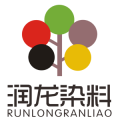Dongguan Runlong Dyes Co., Ltd. has been focusing on directly supplying disperse dyes, reactive dyes, acid dyes, and a small number of other direct dyes to the printing and dyeing textile industry for 18 years. Today’s article will mainly share with you some basic knowledge about disperse dyes.
Disperse dyes are special dyes for dyeing polyester fiber (ie polyester). In recent years, with the rapid development of the petrochemical industry, the development of synthetic fibers has been promoted. Among synthetic fibers, polyester fiber has the highest growth rate. Polyester fiber is a polymer produced by transesterification and polycondensation of methyl terephthalate and ethylene glycol. Polyester fiber, like other synthetic fibers, is a hydrophobic fiber. The long chain of polyester fiber molecules does not contain other strong polar groups except for the hydroxyl groups at both ends. It has very low hygroscopicity, with a hygroscopicity rate of only 0.4% under standard conditions. , about 1/18 of cotton fiber. The internal structure of the polyester fiber is tight and the microcrystalline channels are narrow, so it cannot be dyed with highly hydrophilic dyes (such as reactive dyes, etc.).
Because polyester fiber has the advantages of high strength, good elasticity, strong moisture resistance, and a soft feel, it has a wide range of uses. Its output has grown rapidly, and dispersed dyes have also developed accordingly, occupying a very important position in the dye industry.
Generally, disperse dyes are azo and anthraquinone derivatives with lower molecular weight and do not contain water-soluble groups such as sulfonic acid groups and carboxylic acid groups. It is only slightly soluble in water and requires auxiliaries when dyeing. The function of the auxiliary agent is to disperse the dye evenly in the dyeing solution so that the polyester fiber can be dyed.
To meet market needs, polyester fiber is often blended with natural fibers in industry to make various textiles (such as cotton blends are called cotton fiber, wool blends are called wool-polyester, and silk blends are called silk-polyester). When dyeing these blended fabrics, , In addition to using disperse dyes (fiber), low-temperature disperse dyes often need to use other types of dyes to dye another fiber. The traditional dyeing process generally uses a two-bath method or a one-bath two-step method. This method uses two or more dyes to prepare a dye solution according to the required color. After the fabric is pad-dyed or dip-dyed, it is processed according to the respective fixation process conditions to obtain the required single color. This kind of dyeing method has a complicated process, often produces color differences, and it is difficult to find a better dye combination. In the dispersed dye dyeing industry, it is hoped that a single dye can be used to dye two fibers at the same time using a one-bath and one-step method. The currently used non-ionic disperse dyes have met the requirements for simultaneous printing and dyeing of polyester-cotton blends, that is, a single dye has been achieved. The structural dyes have the same purpose of dyeing two fibers.
Editor:Jiang


